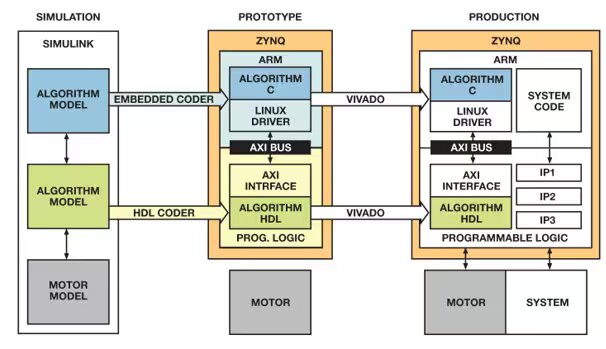Courtesy: Arrow Electronics
Electric motors are widely used in various industrial, automotive, and commercial applications. Motors are controlled by drivers, which regulate their torque, speed, and position by altering the input power. High-performance motor drivers can enhance efficiency and enable faster and more precise control. This article introduces modern motor control system architectures and various motor control solutions offered by ADI.
A modern intelligent motor control system with a multi-chip architecture
With the advancement of technology, motor control systems are evolving towards greater intelligence and efficiency. Advanced motor control systems integrate control algorithms, industrial networks, and user interfaces, thus requiring more processing power to execute all tasks in real-time. Modern motor control systems typically employ a multi-chip architecture, utilizing a Digital signal processor (DSP) for motor control algorithms, Field Programmable Gate Array (FPGA) for high-speed I/O and networking protocols, and microprocessors for handling executive control.
With the emergence of System-on-chip (SoC) devices, such as the Xilinx Zynq All Programmable SoC, which combines the flexibility of a CPU with the processing power of an FPGA, designers are finally able to consolidate motor control functions and other processing tasks within a single device. Control algorithms, networking, and other processing-intensive tasks are offloaded to the programmable logic, while supervisory control, system monitoring and diagnostics, user interfaces, and debugging are handled by the processing unit. The programmable logic can include multiple parallel working control cores to achieve multi-axis machines or multiple control systems.
In recent years, driven by modeling and simulation tools like MathWorks Simulink, model-based design has evolved into a complete design workflow, from model creation to implementation. Model-based design changes the way engineers and scientists work, shifting design tasks from the lab and the field to the desktop. Now, the entire system, including the plant and controllers, can be modeled, allowing engineers to fine-tune controller behavior before deploying it in the field. This can reduce the risk of damage, accelerate system integration, and reduce dependence on equipment availability. Once the control model is completed, the Simulink environment can automatically convert it into C and HDL code that is run by the control system, saving time and avoiding manual coding errors.
A complete development environment that enables higher motor control performance leverages the Xilinx Zynq SoC for controller implementation, MathWorks Simulink for model-based design and automatic code generation, and ADI’s Intelligent Drives Kit for rapid prototyping of drive systems.
An advanced motor control system comprehensively manages control, communication, and user interface tasks
An advanced motor control system must comprehensively handle control, communication, and user interface tasks, each of which has different processing bandwidth requirements and real-time constraints. To achieve such a control system, the chosen hardware platform must be robust and scalable to accommodate future system improvements and expansions. The Zynq All Programmable SoC, which integrates a high-performance processing system with programmable logic, offers exceptional parallel processing capabilities, real-time performance, fast computation, and flexible connectivity. This SoC includes two Xilinx analog-to-digital converters (XADC) for monitoring the system or external analog sensors.
Simulink is a block diagram environment that supports multi-domain simulation and model-based design, making it ideal for simulating systems with both control algorithms and plant models. Motor control algorithms adjust parameters such as speed, torque, and others for precise positioning and other purposes. Evaluating control algorithms through simulation is an efficient way to determine if the motor control design is suitable, reducing the time and cost of expensive hardware testing once suitability is determined.
Choosing the right hardware for prototyping is a significant step in the design process. The ADI Intelligent Drives Kit facilitates rapid prototyping. It supports rapid and efficient prototyping for high-performance motor control and dual-channel Gigabit Ethernet industrial networking connectivity.
The ADI Intelligent Drives Kit includes a set of Simulink controller models, the complete Xilinx Vivado framework, and the ADI Linux infrastructure, which streamline all steps needed for designing a motor control system, from simulation to prototyping, and eventual implementation in production systems.
The Linux software and HDL infrastructure provided by ADI for the Intelligent Drives Kit, together with tools from MathWorks and Xilinx, are well-suited for prototyping motor control applications. They also include production-ready components that can be integrated into the final control system, reducing the time and cost required from concept to production.
Modulators and differential amplifiers to support motor control applications
ADI offers a range of modulators, differential amplifiers, instrumentation amplifiers, and operational amplifiers solutions for motor control applications.
The AD7401 is a second-order sigma-delta (Σ-Δ) modulator that utilizes ADI’s on-chip digital isolator technology, providing a high-speed 1-bit data stream from an analog input signal. The AD7401 is powered with a 5V supply and can accept differential signals in the range of ±200 mV (±320 mV full-scale). The analog modulator continuously samples the analog input signal, eliminating the need for an external sample-and-hold circuitry. The input information is encoded in the output data stream, which can achieve a data rate of up to 20 MHz. The device features a serial I/O interface and can operate on either a 5V or 3V supply (VDD2).
The digital isolation of the serial interface is achieved by integrating high-speed CMOS technology with monolithic air core transformers, providing superior performance compared to traditional optocouplers and other components. The device includes an on-chip reference voltage and is also available as the AD7400 with an internal clock. The AD7401 is suitable for applications in AC motor control, data acquisition systems, and as an alternative to ADCs combined with opto-isolators.
The AD8207 is a single-supply differential amplifier designed for amplifying large differential voltages in the presence of large common-mode voltages. It operates on a 3.3V to 5V single supply and features an input common-mode voltage range from -4V to +65V when using a 5V supply. The AD8207 comes in an 8-lead SOIC package and is ideal for applications like electromagnetic valve and motor control where large input PWM common-mode voltages are common.
The AD8207 exhibits excellent DC performance with low drift. Its offset drift is typically less than 500 nV/°C, and gain drift is typically less than 10 ppm/°C. It’s well-suited for bidirectional current sensing applications and features two reference pins, V1 and V2, which allow users to easily offset the device’s output to any voltage within the supply voltage range. By connecting V1 to V+ and V2 to GND pin, the output is set to half-scale. Grounding both reference pins provides unipolar output starting near ground voltage. Connecting both reference pins to V+ provides unipolar output starting near the V+ voltage. Applying an external low-impedance voltage to V1 and V2 allows for other output offsets.
Low-noise and low-distortion instrumentation amplifiers and operational amplifiers
AD8251 is a digitally programmable gain instrumentation amplifier with features including GΩ-level input impedance, low output noise, and low distortion. It is suitable for interfacing with sensors and driving high-speed analog-to-digital converters (ADCs). It has a 10 MHz bandwidth, -110 dB total harmonic distortion (THD), and fast settling time of 785 ns to 0.001% accuracy (maximum). Guaranteed offset drift and gain drift are 1.8 µV/°C and 10 ppm/°C (G = 8), respectively.
In addition to its wide input common-mode voltage range, the device has a high common-mode rejection capability of 80 dB (G = 1, DC to 50 kHz). The combination of precision DC performance and high-speed capabilities makes the AD8251 an excellent choice for data acquisition applications. Moreover, this monolithic solution simplifies design and manufacturing and enhances the performance of test and measurement instrumentation through tightly matched internal resistors and amplifiers.
The AD8251 user interface includes a parallel port where users can set the gain in two different ways. One method is to use the WR input to latch 2-bit word sent over the bus. The other is to use the transparent gain mode, where the gain is determined by the logic level states at the gain port.
The AD8251 is available in a 10-lead MSOP package and is rated over the -40°C to +85°C temperature range. It is well-suited for applications with strict size and packaging density requirements, including data acquisition, biomedical analysis, and testing and measurement.
AD8646 is a 24 MHz rail-to-rail dual-channel operational amplifier. Additionally, AD8647 and AD8648 are dual-channel and quad-channel, rail-to-rail input and output, single-supply amplifiers with features such as low input offset voltage, wide signal bandwidth, low input voltage and low current noise. AD8647 also features low-power shutdown.
The AD8646 series combines a 24 MHz bandwidth with low offset, low noise, and extremely low input bias current characteristics, making these amplifiers suitable for a variety of applications. Devices such as filters, integrators, photodiode amplifiers, and high-impedance sensors can benefit from this combination of characteristics. The wide bandwidth and low distortion characteristics are beneficial for AC applications. The high output drive capability of AD8646/AD8647/AD8648 makes them ideal choices for driving audio line drivers and other low-impedance applications, with AD8646 and AD8648 suitable for automotive applications.
The AD8646 series features rail-to-rail input and output swing capabilities, enabling design engineers to buffer CMOS ADCs, DACs, ASICs, and other wide-output swing devices in single-supply systems.
ADA4084-2 (dual) is a 30 V, low-noise, rail-to-rail I/O, low-power operational amplifier, along with ADA4084-1 (single) and ADA4084-4 (quad). They are rated over the -40°C to +125°C industrial temperature range. The single-channel ADA4084-1 comes in 5-lead SOT-23 and 8-lead SOIC packages; the dual-channel ADA4084-2 is available in 8-lead SOIC, 8-lead MSOP, and 8-lead LFCSP packages; ADA4084-4 is offered in 14-lead TSSOP and 16-lead LFCSP packages.
ADA4084-2 supports rail-to-rail input/output and has low power consumption of 0.625 mA (±15 V, typical per amplifier), a gain bandwidth product of 15.9 MHz (AV = 100, typical), unity gain crossover frequency of 9.9 MHz (typical), and supports a -3 dB closed-loop bandwidth of 13.9 MHz (±15 V, typical) while providing low offset voltage of 100 μV (SOIC, maximum), unity gain stability, high slew rate of 4.6 V/µs (typical), and low noise of 3.9 nV/√Hz (1 kHz, typical).
Conclusion
Modern motor control systems, combined with tools and systems from FPGA, MathWorks, Xilinx, and ADI, can help achieve more efficient and precise motor control solutions. By integrating MathWorks’ model-based design and code generation tools with powerful Xilinx Zynq SoC and ADI’s isolation, power, signal conditioning, and measurement solutions, the design, validation, testing, and implementation of motor drive systems can be more efficient than ever before, thereby improving motor control performance and shortening time to market. ADI’s Intelligent Drives Kit provides an excellent prototyping environment to expedite system evaluation and assist in quickly starting motor control projects. Interested customers are encouraged to learn more.











